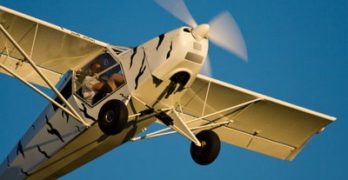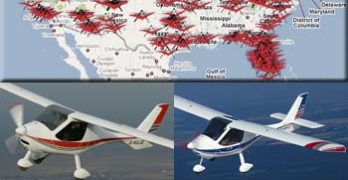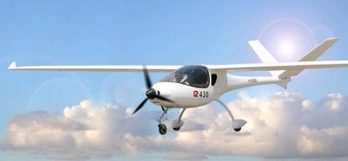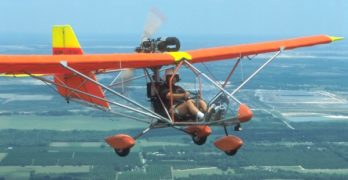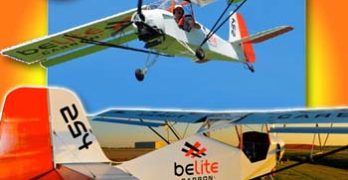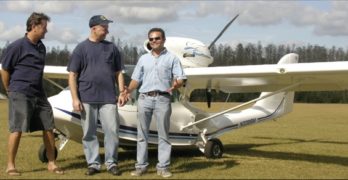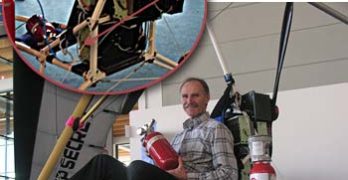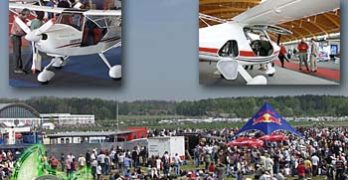Great (and getting hot!) weather and a good, if not record-breaking, turnout mark the beginning of the EAA Sun ‘n Fun flyin. *** The exhibitor turnout is likewise somewhat down, although Dan Johnson’s LSA Mall at the entrance is filled with aircraft and lots of serious interest from potential buyers, as in previous shows. *** I’ve talked with many LSA companies here who say there are more serious buyers, fewer “tire-kickers”. *** Some LSA makers like Flight Design have racked up aircraft sales already. Others are still hoping to do business: it depends on who you talk to on whether the show is better or worse than expected. Expectations due to the economic times were not high to begin with, so it’s too early to put a number on the overall picture. *** Lots of new developments though, with more details to come here, such as: *** * a new electric/Rotax hybrid engine that will boost economy and provide electric power safety backup in emergencies, announced at AERO Friedrichshafen *** * Evektor passes LAMA audit *** * Legend Cub offers sub-$100,000 “Aeronomic Stimulus” SLSA, and new Garmin 696 installation *** * EAA presents Earth Day celebration with electric LSA prototype in center of the LSA exhibitors in the southeast display mall.
Search Results for : electric
Not finding exactly what you expected? Try our advanced search option.
Select a manufacturer to go straight to all our content about that manufacturer.
Select an aircraft model to go straight to all our content about that model.
ZAP! Goes the Revolution
I have seen the future and it is electric. Lots more to say about this than I have time, space or energy here, after my first day at Oshkosh, but this much is clear: electric flight is a reality, just as the Wright Brother’s Flyer made heavier-than-air flight a reality. *** I spent an hour talking with the Yuneec E-430 people. *** FACTOIDS: *** * Made in China *** * The company just built a new 250,000 sq. ft. factory. That’s right: 1/4 MILLION square feet! *** * Company has initial plans to produce 6 different electric flying craft: ultralights, trikes, powered parachutes, hang gliders…and the sleek, beautiful, 45-foot wingspan E-430 (above) that went from light bulb idea to flying prototype in 4 months! *** * Getting FAA to amend LSA reg to admit electric power will take some doing. But you can’t stop a flood tide. *** Also saw Flight Design’s Tom Peghiny wow the crowds in the waning light at the Ultralight flying area with his E-Spyder, also powered by a Yuneec prototype electric propulsion system.
Flight Design… “Has a Map for That”
If you study FAA’s registration database as I do, you’ll quickly discover that Flight Design and its various CT models have a strong presence in the USA (the world for that matter, with 1,500 flying, according to the company). Since CT was first certified in April 2005 — the second LSA to win Special LSA certification, after Evektor’s SportStar — the German brand has steadily planted CTs across America. You can see a CT at more airfields than any other brand by more than double; the next closest is the American Legend Cub. *** The accompanying graphic was created by Flight Design USA to show the locations of more than 300 CT aircraft in the United States. The distribution is surprisingly even with obvious concentrations in big aviation states such as Florida, California, and Texas/Oklahoma with another area of strength in New England, home base of the U.S.
Watt’s Up!
Getting ready for Oshkosh, and my first in-person look at an exciting new electric airplane which you’ll be hearing a lot more about in the months ahead. *** The Yuneec International E430 electric-powered two seater is in Phase 2 test flight mode. *** The bird is fitted with a 54 hp electric motor that weighs only 37.5 lbs., uses six lipo (lithium polymer) batteries and is capable of 1.5 to 2 hours of flight. *** And that’s with a 400 pound payload! A 10-battery configuration should bring duration to 2.5 hours. The sleek highwinger sports a 45-foot wingspan. Could that mean motorglider cred too? It gives the LSA a 25:1 glide ratio. Handling in strong winds could be a challenge with that wing and V-tail, but we’ll have to wait and see. *** Should motorgliding be enabled in future, perhaps with a folding prop, restarts would be a breeze.
Aero-Lite Revisited
[UPDATE fall 2009 — Aero-Works left the business several years ago (though in late 2009, originator Terry Raber said he will return to production). Meanwhile, producer Wings of Freedom has begun work on the Phoenix-103, a derivation of the Aero-Lite 103 but with numerous small changes.
This article refers to the aircraft built by AeroWorks and will not be identical to the Aero-Lite 103. The companies are different and Terry Raber has no association with Wings of Freedom.
In the uncertain “new world of Sport Pilot,”
one thing remains exactly as it was – FAR Part 103. While new rules and regulations may shake the ground under the feet of ultralight pilots, Aero-Works continues to produce their popular AeroLite 103. If you build it carefully, you can still enjoy a twin-cylinder ultralight with lots of features that fits Part 103.
Even airline pilots who normally fly under smothering regulations appreciate FAA’s simplest, least intrusive rule, Part 103.
Belite’s Carbon Fiber Part 103 Ultralight Vehicle
If you’ve been around aviation long enough you’ve heard the Q&A: “Know how to make a small fortune in aviation? Start with a large one!” Yet aviation can always use fresh talent, so welcome former tech entrepreneur, James Wiebe, turned aviation businessman. From his days building Mac peripherals under the name Newer Technology (and reaching sales of $60 million), Wiebe sold his tech enterprises and, in January 2009, bravely launched Belite Aircraft. The first flight came July 4th.
Wiebe chose to incorporate stronger, lighter carbon fiber technologies to replace steel, wood, and aluminum. The result is a three-axis, full-cockpit airplane with a full instrument panel that can be built to weigh less than Part 103’s 254-pound maximum. Though employing plenty of costly carbon fiber including on the firewall, Belite uses a welded steel frame for strength and safety. The premium Belite 254 CF includes carbon fiber wing spars and ribs, hydraulic brakes, aluminum wheels, full flight instrumentation, built in transceiver, a bigger 45-hp engine, enhanced electrical system, and a Gizmo GPS dock.
Triple Play: Fk Lightplanes Is High, Low, and Bipe
Light-Sport Aircraft are nothing if not diverse. We have all manner of aircraft on our SLSA List of 104 approved models. Germany’s FK Lightplanes illustrates diversity through their trio of models: high wing Fk9 series; biplane Fk-12; and low wing Fk14. *** In May 2009, the newest iteration of the Fk9 series was flown by designer Peter Funk. The Fk9 ELA (a reference to European Light Aircraft, a new class EASA is planning) is a stretched, roomier model of the popular series. The changes should play well in the American market. *** Peter Funk commented, “It seemed that [Fk9 ELA’s new] winglets are improving control efficiency and low speed characteristics.” In addition, the newest model boasts a larger cabin space, a larger panel with room for big screens, more baggage area, electric flaps, and optional longer-range fuel tanks. The versatile Fk9 ELA is also available on straight or amphibious floats or in taildragger gear.
AirMax SeaMax, Elegant Engineering
Let’s consider light amphibious aircraft – the boathull variety, not floatplanes
– but including both freshly designed, fully built light sport aircraft
along with kit aircraft born of the ultralight heritage.
In the last year, the exceedingly handsome Icon A5 has made quite a splash, literally
and figuratively. However, the A5 is more than a year away from first deliveries
and an order placed today might not be delivered until 2011 or later. Another LSA
amphibian called the Mermaid was designed and introduced by Czech Aircraft
Works of SportCruiser fame. Although five are available in the country, sales have
yet to take off.
Another popular American seaplane, the SeaRey, is moving toward ASTM
approval but remains a kit that asks several hundred hours of a builder’s time. The
simpler and faster-build Aventura models also remain available; this design has
been on the market for many years. Either kit is less costly than a fully built aircraft,
but all seaplanes have loftier price tags to cover their ability to operate on land
or water.
Lighter-Than-Air… But Not An Airship
Research and practical applications are developing rapidly for electric-powered aircraft. Given my personal fascination, I’ll follow this regularly. So far, most electric power has been supplied by batteries — even in such as Flight Design’s hybrid aircraft engine unveiled at Aero 2009 However, that’s only one way to generate electric “fuel.” Hydrogen is another.
Forget fears of a Hindenburg airship exploding; even that fireball was likely precipitated by something other than hydrogen in the envelope (its paint is suspect). Today, the source is a relatively small tank of hydrogen (photo), supplied by companies like Messer which is sponsoring the work of Gerard Thevenot in creating his hydrogen fuel cell-powered trike.
Ultra-lightweight aircraft like trikes are a perfect platform for experimentation and Thevenot knows all about them. Gerard founded La Mouette, once the world’s largest producer of hang gliders. He’s highly inventive and well suited to such a project.
German Aero Show Takes On Added Importance
In the picturesque south of Germany, Aero Friedrichshafen has become a popular show that has long presented light aircraft in a prominent way. (That makes sense as “sport” flying dominates 80% of European aviation.) Housed in several cavernous halls, Aero offers an enormous range of interesting aircraft; Aero runs April 2-5. *** Though I love this show, the main reason I’m going is to interact with European officials moving toward acceptance of ASTM standards. A Certification Specification for Light Sport Aircraft (CS-LSA) is working its way through the European Union and at Aero, some key meetings are planned to help EASA personnel get with FAA people and ASTM committee members. Dull? Maybe… But look at the prize: the potential for a worldwide standard for LSA. Upon acceptance, American producers could work to enlarge their market in Europe at dramatically lower cost than for Type Certificated airplanes, which must gain approval country-by-country.
- « Previous Page
- 1
- …
- 46
- 47
- 48
- 49
- 50
- …
- 67
- Next Page »


